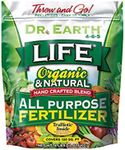Buying Guide for the Best Fruit Tree Fertilizers
Choosing the right fertilizer for your fruit trees is essential for ensuring healthy growth and a bountiful harvest. Fertilizers provide essential nutrients that trees need to thrive, but not all fertilizers are created equal. Understanding the key specifications and how they relate to your specific needs will help you make the best choice for your fruit trees. Here are the key specs to consider when selecting a fruit tree fertilizer and how to navigate them.N-P-K RatioThe N-P-K ratio represents the percentage of nitrogen (N), phosphorus (P), and potassium (K) in the fertilizer. Nitrogen promotes leafy growth, phosphorus supports root development and flowering, and potassium enhances overall plant health and disease resistance. For fruit trees, a balanced ratio like 10-10-10 or one slightly higher in potassium, such as 5-5-10, is often recommended. Choose a ratio based on the specific needs of your trees; for example, young trees may benefit from more nitrogen to encourage growth, while mature trees might need more potassium for fruit production.
Type of FertilizerFertilizers come in various forms, including granular, liquid, and spikes. Granular fertilizers are easy to apply and provide a slow release of nutrients over time. Liquid fertilizers offer quick nutrient absorption and are ideal for immediate nutrient needs. Fertilizer spikes are convenient and provide a steady release of nutrients directly to the root zone. Consider your application preference and the specific needs of your trees when choosing the type of fertilizer. For example, if you prefer less frequent applications, granular or spikes might be more suitable.
Organic vs. SyntheticOrganic fertilizers are made from natural materials and improve soil health over time, while synthetic fertilizers are chemically formulated for immediate nutrient availability. Organic options, such as compost or manure, are environmentally friendly and support long-term soil fertility. Synthetic fertilizers provide precise nutrient ratios and are often more affordable. Choose organic if you prioritize sustainability and soil health, or synthetic if you need quick results and specific nutrient control.
MicronutrientsIn addition to the primary nutrients (N-P-K), fruit trees also require micronutrients like iron, zinc, and manganese for optimal growth. These micronutrients are often included in complete fertilizers. Check the label to ensure the fertilizer provides a comprehensive nutrient profile. If your soil is deficient in specific micronutrients, look for a fertilizer that addresses those needs. Soil testing can help determine which micronutrients are lacking.
Application FrequencyDifferent fertilizers have varying application frequencies, ranging from once a year to monthly applications. Slow-release fertilizers typically require fewer applications, while liquid fertilizers may need to be applied more frequently. Consider your maintenance schedule and how often you are willing to fertilize your trees. If you prefer low-maintenance care, opt for a slow-release fertilizer that requires less frequent application.


















